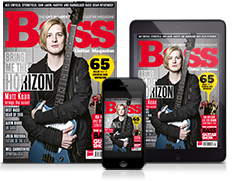Marcus Miller in-depth: Miles, Luther, gear, playing tips and more
"In my neighbourhood, if you weren’t playing that big slap bass style, you weren’t getting a listen!"
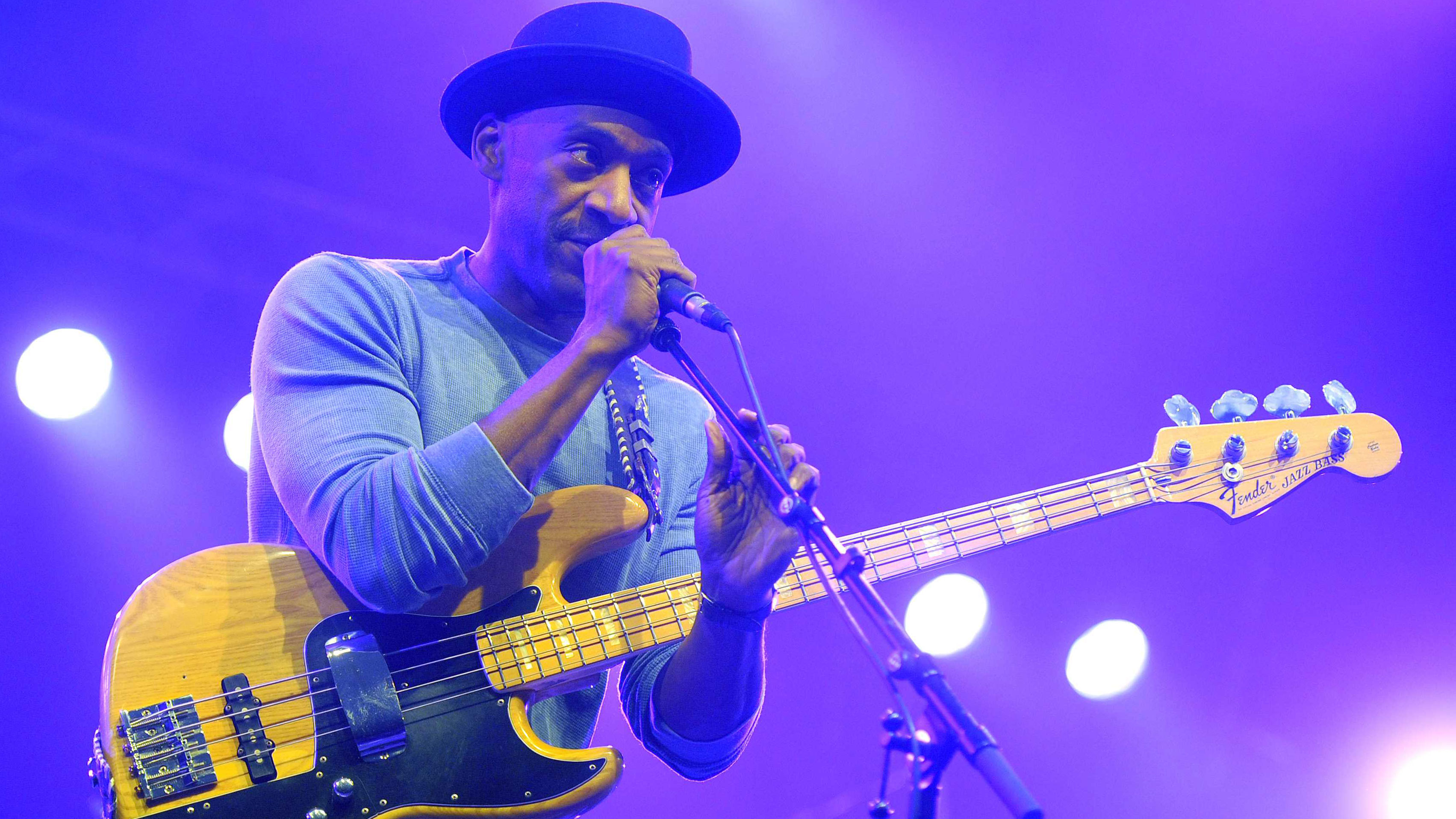
Miller time
When it comes to bass experience, Marcus Miller has world-class credentials, including playing with and writing for jazz legend Miles Davis, being the bassist of choice for soul singer Luther Vandross, and limitless sessions for musicians as diverse as Michael Jackson, Bryan Ferry, and Frank Sinatra.
He last released an album – the excellent Afrodeezia – back in 2015, but that doesn’t mean the 58-year-old icon is taking it easy: if anything, he’s travelling more than ever before, taking in live dates and sessions around the world on what appears to be a near-constant basis.
The man is at the peak of his powers, so we couldn’t wait to sit down with him and find out what’s happening in his world. Equally importantly, we want to know if he can advise us on our own routes towards bass mastery. Will we ever get there, and if so, can he show us the way? Read and learn...
What are you up to at the moment, Marcus?
"I have a strong worldwide audience, but it takes two years to get to everybody – so we go everywhere, Australia, Asia, Africa, South America, Europe, Eastern Europe, China... it takes a long time to get around.
I spent the first half of my professional life in the studio – I never saw sunlight
"I spent the first half of my professional life in the studio – I never saw sunlight – and then once I started making my own records, the music business changed. CDs weren’t selling, but if you’re a good enough performer, there are still opportunities.
"Now I have an awareness of who I’m making music for, because right after the shows, I’m talking to fans online."
Tell us about your work outside of music.
I’m an Artist Of Peace with UNESCO, the goodwill arm of the UN. They try to promote peace around the world, and the first step to peace is communication, so they enlist international artists to promote that message.
"You and I know the history of slavery, but the kids growing up aren’t as familiar with it – so we want to make sure they don’t remain completely ignorant of the story, because that’s how things start again.
Drummers say, ‘Hey man, we play real good together.’ And I say, ‘No man, I play real good with you.'
"On my last album, Afrodeezia, I was reminding people of what happened, to look how strong people are to endure a situation like that but still find joy, particularly through the cathartic process of making music.
"Blues, spiritual music, jazz and R&B all come through experience, and I decided for that album, I would follow the roots of Atlantic slavery."
Who mentored you in the early days?
"I was a student of Ralph McDonald, a fabulous percussionist who was on every record in the 70s and 80s and had a huge hit called ‘Calypso Breakdown’ on the Saturday Night Fever soundtrack [1977]. He got me my start.
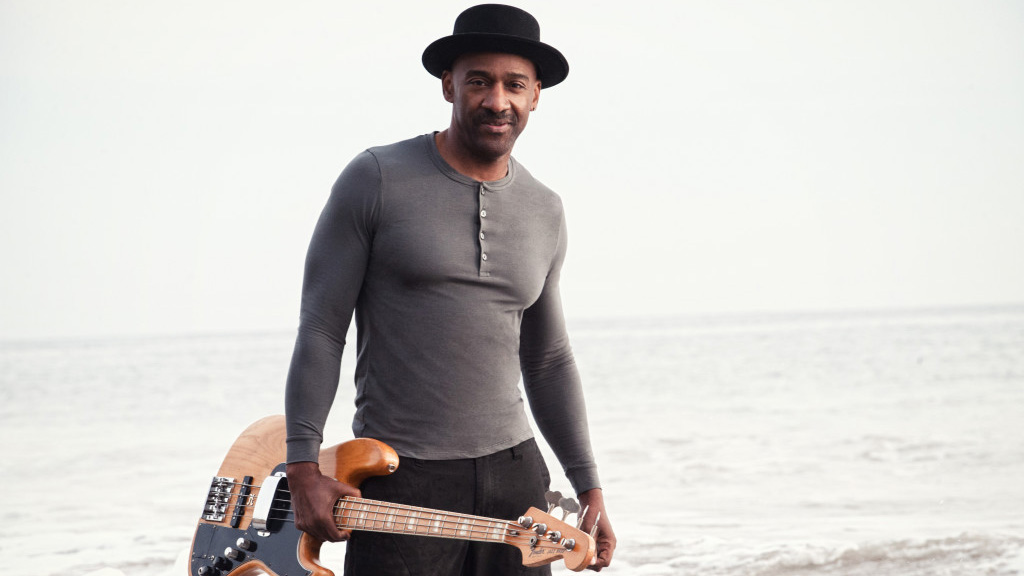
"I wrote a song for a flautist who Ralph was producing, and he asked me, ‘Can you read music? Don’t bullshit me, because I’m about to recommend you on the studio scene.’
"I said ‘Dude, I can read fly shit! I majored in classical clarinet – no bass-line will give me a problem.’ Within two months I was working every day: he started the word of mouth [about me]."
You learned how to lock in with a drummer from the great Lenny White of Return To Forever. Tell us about that.
"Locking in is a skill that a lot of players overlook, and it is very important. As a studio musician, you learn to lock in with a lot of different drummers, and of course, they’re all different.
"They all have a very different way of playing. Sometimes it’s ba-boom; other times it’s baaa-boom! To everyone else who’s listening, they sound the same, but the bass player’s job is to find that sweet spot and hold it with the drummer.
"Some play on top of the beat, some sit behind it, some go a little in front. Your job is to figure out which way it is, and match it. Drummers don’t even notice: they say, ‘Hey man, we play real good together.’ And I say, ‘No man, I play real good with you – it’s me making all the adjustments here!’ "
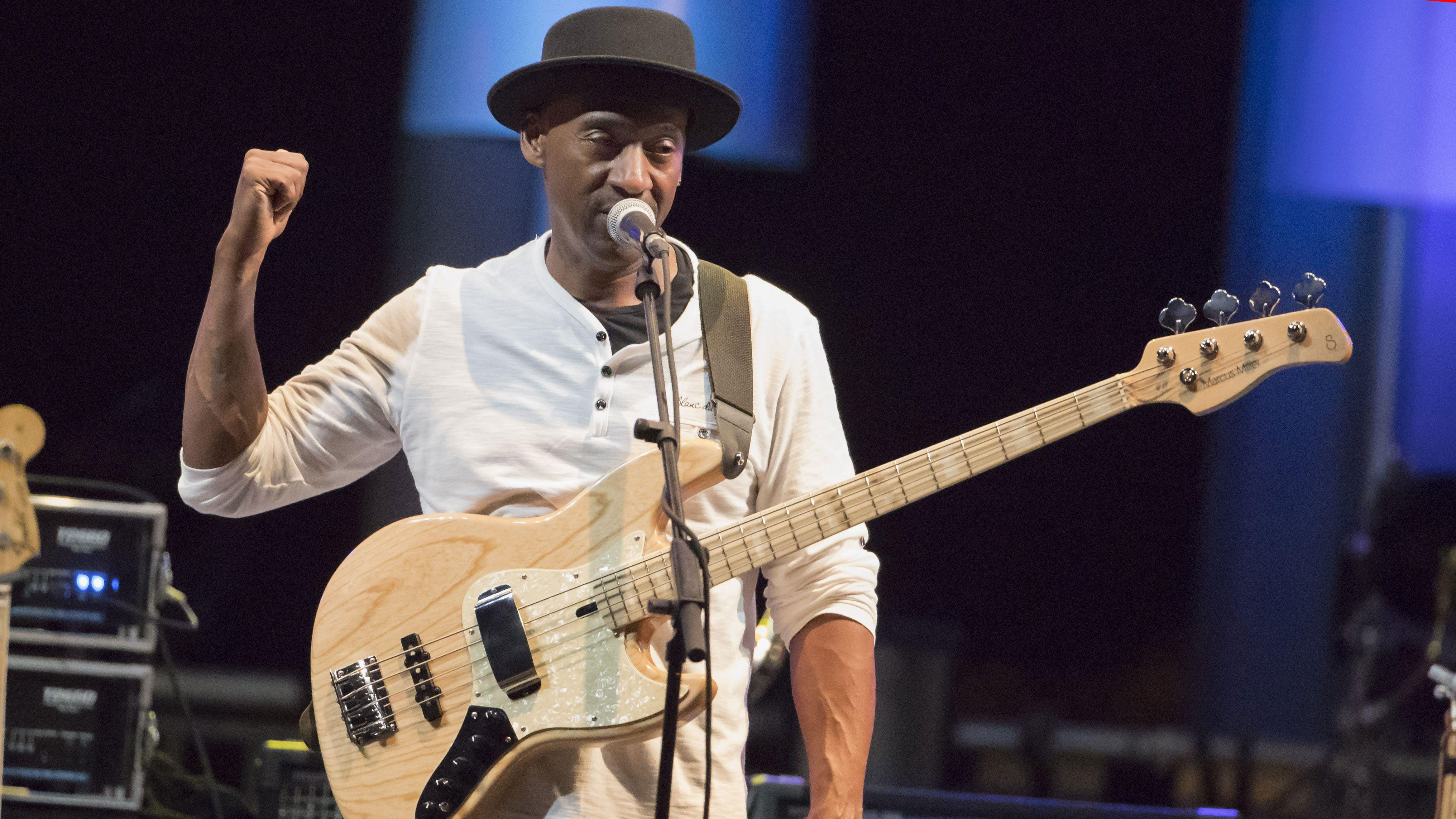
Jazz man
Tell us about the basses you played when you were starting out.
"I got my first Fender Jazz when I was 14, but that got stolen so I got a natural Jazz in 1977.
"I chose the Jazz for a couple of reasons. There weren’t many basses around back then: if you played bass, you were looking at a Jazz, a Precision, a Gibson EB-3 if you liked that sound, or a Rickenbacker – and that was it.
"Everyone was playing Fender, it was the industry standard. I was 17 so I didn’t know a lot about what went into a bass to make it sound the way it does."
How come you ended up going for a Jazz rather than a Precision?
"The Jazz had two pickups, the Precision had one – and I figured two pickups had to sound better than one! Also, the Jazz cost a little bit more, which pointed me towards it, and the neck was a bit smaller.
"My heroes such as Larry Graham and James Jamerson both played Fenders. I’ve been playing them my whole life, so all of their characteristics have been incorporated into my playing. My fingerstyle playing doesn’t jump off the fingerboard, so I started playing with my thumb.
"All my heroes played with just one bass. Nobody was switching basses for different songs, and a Jazz bass works in most situations. I made it work for me in every situation."
From producing Luther Vandross, you can imagine how much I learned about what really goes into singing.
What was your tone like back then?
"When I was around 14, I played in a talent show in Queens in New York, and I thought I sounded just fine, with lots of booming bottom end and a pingy high sound up the top.
"What I didn’t know was that there was no definition because the midrange wasn’t there. I had missed the middle out of the sound completely. The next day everyone was talking about it – and remember, this was the hood: they don’t go easy on you! I was told that my bass sounded like mud, and one guy told me that you have to turn up the midrange to get a good sound.
"Hell, I was 14, I didn’t know that – but it was a lesson I learned that day, and I ain’t gone back since. My own sound doesn’t have full midrange, but that’s my sound.
"I recommend you keep your midrange humming to get heard right. Nowadays, with my signature basses from Sire and the strings we developed with Dunlop, my sound comes naturally."
You’ve mentioned the importance of learning from professional vocalists.
"There’s a lot of joy in singing, so when I’m feeling it, I do it. On the bass, I’m very influenced by vocalists. From producing Luther Vandross, you can imagine how much I learned about what really goes into singing – tone, phrasing, the idea that being in tune isn’t always right, and when to use vibrato.
"You hear fretless players always playing with vibrato to hide the fact their intonation is out: you can use it to round a note off, but if you don’t work with a singer, or you don’t sing yourself, you won’t really understand it. Even singers get it wrong!
"As human beings, if you can own whatever it is you got, you can win. People respect that."
I know the horn isn’t for everyone, but I do encourage bass players to learn to play piano.
Should bass players investigate other instruments, too?
"Playing a horn definitely develops your musical appreciation in terms of understanding harmonies. You learn how to avoid inappropriate notes, like playing a harmony fifth against a flat fifth – unless that’s the effect you want, of course.
"A lot of bass players stay down at the bottom end of the music, and they have no interest in what’s going on up at the other end. I know the horn isn’t for everyone, but I do encourage bass players to learn to play piano.
"I don’t say you have to be able to play it like Herbie Hancock, but you should learn the basic chords, because then you can understand how your bass notes relate to the chord structures which the rest of the band are playing.
"Knowing and understanding what’s going on around you can only make you a better musician."
Your slap style was influenced by the man who invented it.
"Yeah man, Larry Graham. Larry had been with Sly & The Family Stone, and by the time he was out with his own band, Graham Central Station, he had that bass right out there at the front of the mix.
"In my neighbourhood, at that time, if you weren’t playing that big slap bass style, you weren’t getting a listen! Stanley Clarke was another bassist at that time who moved from stand-up to electric bass, and he really opened up the sound of the instrument too.
"When I started making records with Luther, I started playing a lot of ballads, and I was using my thumb to get a lot of range and tone into my sound. Taking the bass sound further and getting a signature sound was part of my development back then."
You recorded six albums with Miles Davis in the '80s. What was it like working with someone like him?
"I was 21 years old when Miles called me in 1980. If he’d called me and told me he needed me in a month, I could have had time to completely psych myself out and be a total mess by the time the session came around. But I didn’t, I had about two hours!
"I told him I had to finish the session I was doing, and then I’d walk over to Columbia Studios where he was recording. All the New York studios are in a 10-block area around Times Square, so you put your bass bag on your back and walk from one to the next.
"I met Miles, and within half an hour, we were in the studio, playing together."
It must have felt surreal.
"I didn’t have time for any soul-searching – I just knew that this was my chance. I told myself, ‘This is Miles Davis: he could call any bass player in the world to do this session, and they’d be there, but he called me!’
"This was my chance to not be what I thought Miles wanted me to be: I had a chance to be me, to put my signature on a Miles Davis record, so I had to dig deep and find it.
"This was something that I’d wanted since I was 17 years old. This was my moment, and I took it with both hands.
"If you check out the first album we did, The Man With The Horn [1981], that’s my sound on there. I was still a young player, I was developing my thing... but I found my sound on that album."
How has the session scene changed?
I became known as the guy who could come down, plug in, read the score, hit the feel, nail the session, and go, no bother at all
"You have to remember that the New York studio session scene in the 70s, when I got started, was real busy, man. I would work three or four sessions a day, maybe 16 or more sessions a week.
"Now, a lot of studio time used to be devoted to getting the guitar sound right, which is difficult to do. So if I came in with my sound ready to go, I was already ahead of the game.
"I became known as the guy who could come down, plug in, read the score, hit the feel, nail the session, and go, no bother at all.
"These days, you get your buddy in who plays bass a bit, and he plunks a few notes, and you fix it all up with Pro Tools! But you know what, there is still a market for a bass player who can play it through in one take and make you feel it.
"There’s still plenty of people who want a sound like that. As long as there are people who want a real genuine musician who can read and play and feel the vibe, then I got a gig."
Is being easy to work with an important asset for you?
"Absolutely. You should certainly know your instrument well, and know how to make it sound how you want it to sound. I would make sure I could create my own bass sound myself, and then the engineer had that much less to do in getting the sound right.
"There’s nothing an engineer likes more after he’s got sounds ready from a guitar, and then drums, and then keyboards, and then vocals, than me saying, ‘I’m good to go man, when you’re ready.’
"That can make you a popular guy, because it gets you known as someone who is a whole lot less trouble than the guy they used last week, so they’re gonna bring you back next time, which is what you want."
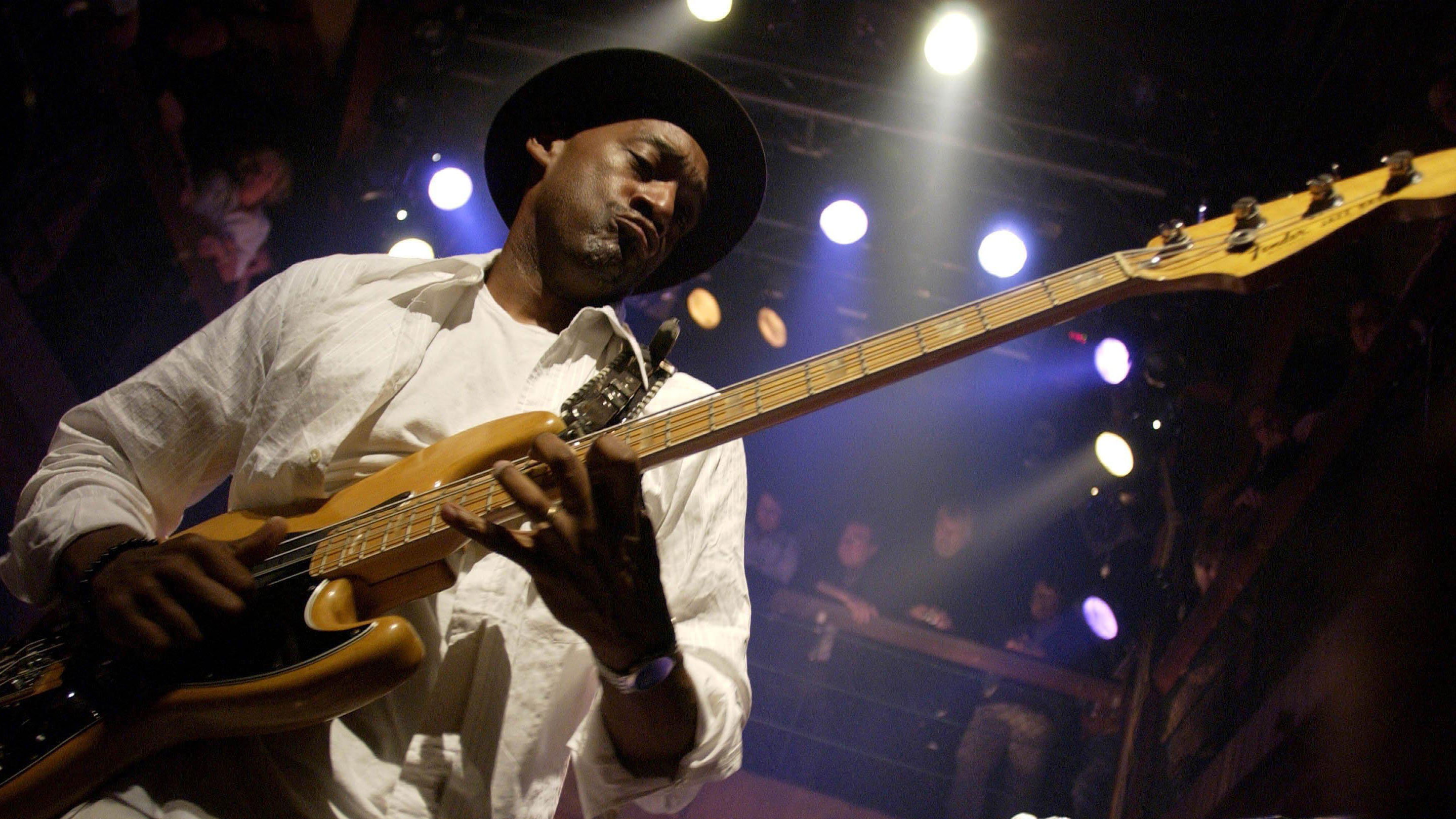
Voice > range
Do you like direction, or do you prefer to put your own way of doing things onto a song?
"It depends. Sometimes you get a very detailed, carefully-written score to play, and that means you play what is written for you, because someone has taken the trouble to work out that score.
"It has notes for you that other notes from other musicians are going to lean on. You can tell right away if that’s how things are shaping up, and you fit in, because they’re not looking for your stamp today, they’re looking for your skill in finding their voice for their lines.
"Other days, you get an MD or a producer who says, ‘I really don’t know what I’m looking for here.’"
What do you do when that happens?
"You can suggest things, and play lines different ways, and together you work out what is going to sound best for the track.
"I know bass players who have put down bass-lines that are absolutely essential, memorable sounds on a track that has gone on to sell millions of copies – but because they didn’t get a composer credit, the main writer is getting royalty cheques 30 years on, and the bass player is still hustling around for the next gig.
"That never happened to me, I didn’t stay a studio player long enough for that situation to come up, and I started writing my own material when I was still a young guy."
I remember someone asking me ‘What’s more important, grooving or being able to play solo?’, and I said, ‘Who allowed you to make that decision?’
Should bassists work on their technical chops, or focus on pocket and groove?
"I remember someone asking me ‘What’s more important, grooving or being able to play solo?’, and I said ‘Who allowed you to make that decision?’
"Do you ever ask a piano player, ‘Do you accompany or do you solo?’ It’s the most ridiculous question I’ve ever heard.
"As a musician, you realise you have limitations and you have to accept those limitations. If you’re a guy who doesn’t have the technique to solo but you have the feeling to groove, stick to what you know.
"But as a young person, you should be aiming to be Paul Chambers. Groove your ass off. You can express yourself and then get back to grooving."
Do you personally have a preference for either of those roles?
"Playing groove is as hard as soloing. As a studio musician, I played with headphones on for 20 years, so I learned where the bass sits with the drums.
"I listen on such a detailed level to what makes it work and doesn’t work. It’s not just about playing on the beat: it’s about feeling the tempo, and knowing what should be in front, what should be behind and what should be played on – stuff that a lot of people would not recognise."
So how should bass players choose the right path?
"What kind of bass player do you want to be? For me, in the neighbourhood and musical environment I grew up in, you had to have a style.
"Nobody cared how fast you played: actually we laughed when a cat came in playing fast. ‘Oh, okay... you spend a lot of time by yourself don’t you?’
"You had to have an identity: you had to live with your instrument night and day, and that’s what I did."
Let’s talk gear. Do you have any advice about buying bass guitars?
"Again, it depends what sort of a bass player you want to be. The bass guitar has been evolving quickly over the last few years, and you can hear that the accent is often now on the ‘guitar’ part of the bass guitar, rather than the ‘bass’ part like it always was years ago.
"If you go on YouTube, you will see a lot of guys playing five- or six-string basses, playing solo. That’s cool if that is the direction you want to go in, but that’s not the sort of bass player I wanted to be when I started out."
How did you achieve the right tones back in the day?
The most important thing to me, is that when you hear me play, you know it’s me. You hear it, and you think that’s Marcus Miller. You may not like what I’m playing, but you still know it’s me
"If I needed a warm sound, I’d play closer to the neck and stick to the neck pickup. For fusion I’d stick to the bridge pickup. I started with flatwound strings in the mid-70s, then I tried roundwounds, followed by halfwounds.
"There were two types of studio musician – one was the guy who can sound like anybody, and he works for every situation, and the other guy sounds like himself and makes that work in all situations. I began to evolve into the second example.
"I’ve done sessions for the likes of Whitney Houston and Mariah Carey where you wouldn’t know it was me. They called me because they knew how I sounded. People stopped calling me to sound like everybody: instead, they called me to sound like me.
"The most important thing to me, is that when you hear me play, you know it’s me. You hear it, and you think that’s Marcus Miller. You may not like what I’m playing, but you still know it’s me."
Was a less defined sound the norm back then?
"Back then, a player would be on the lookout for a bass with a real good boomy bottom-end sound, because he would be looking to be the floor of the sound for the band he was in, or looking to get with.
"In that case, you don’t want a five- or six-string bass with loads of high-end frequency, because it won’t suit the purpose you’re buying it for.
"Check out a good low-end sound with lots of articulation, that’s very important as well. There are plenty of really good manufacturers out there now."

Do you play extended-range basses?
"There are a lot of fabulous musicians out there who like the high frequencies, and they go for the five- and six-string models.
"I have a Marcus Miller Signature five-string, and a six-string, and I play them, but I’m concerned with where my musical voice is, and a four-string bass guitar is the instrument I’ve been playing all my life as a musician.
"I believe your voice is more important than your range. If I need extra notes, I just do what we all used to do, and detune that E string."
Tell us about the preamps you’ve used over the years.
"The first one I ever got was made by a company called Stars Guitars, and I used that one until it blew up on me one day. Then I bought a Bartolini.
"Really, all the preamp allows you to do is to mix your own sound the way the engineer would, if he knew exactly how to get the sound you want. You can adjust the bass and the middle and the top end of the sound.
"Now although I do recommend a good middle sound for the bass, my own signature sound which I’m recognised for is a little different – I have the bass and top ends boosted, and the middle is pushed back a little bit.
"That accentuates the brightness at the top and the solid sound at the bottom, and that’s how I like my bass to sound."
What was your input into the signature Fender that you played for many years?
"My input consisted of handing my Jazz over to Fender in Japan. They asked if they could have it for a week, so I gave it to them and then measured it every way to Sunday, and documented every single thing about it, and made a prototype.
"I played that, and we did some tweaking between us, and got it sounding how I wanted it to sound. They got it so good: I could pick one up anywhere in the world and play a gig with it, no problem."
Is it true you haven’t changed the pickups on your original Jazz bass since 1977?
"Man, I ain’t messed with anything! You hear guys saying, I just put some new pickups in, and the sound is so fine… and I can’t hear the difference! You must remember this: what sounds good in the music store may not sound anything like that good on stage or in a studio.
"You get that high ringing tone, which sounds so fine in the store, and you get on stage, and the cymbals will eat that right up in front of you. And the opposite applies: a good mid-range sound which honks at you in the store and sounds terrible will give you nice balance on stage with a band around it."
I watch modern players, and they play with just their hands, not using their ears.
What effects do you use?
"I like things simple onstage. I have a bunch of pedals, but they’re just for fun, really. I use a delay once in a while, and a distortion, but the main sound is direct, bypassing the amp, and then the engineer mics the amp separately, and mixes the two. That gives a nice raw edge to that live sound."
What’s your take on instructional films for bass?
"No-one has good ears any more, man! I’ve still not made an instructional video, because I’m uneasy about someone watching what I do and copying me visually.
"That doesn’t teach you the right way at all. When I learned the sound, two or four bars at a time, that made my ears real sharp, and that matters to me even today.
"I can hear something once and play it right back to you as accurately as I can repeat back a sentence you just said to me."
Sounds like something all of us can learn from.
"I watch modern players, and they play with just their hands, not using their ears. They hope their hands will give them a good solo.
"Me, I know exactly what I’m going to play before I play it. I know Stanley does, and I know Jaco did too. What I did when I learned a piece, was to play it so I understood it properly. I still do that now.
"I may not be excited musically by a lot of what I hear, but there are always things to be learned – so never isolate yourself from any music. Listen to anything and everything, and learn that way."
Has your playing changed over the years?
"As a player, I’m always trying to grow. I might focus on one aspect, but I try not to make that the main thing. I have to write songs.
"Kids focus on technique, but it’s my job to make them grow up. Yes, technique is cool – but it has to have a purpose.
"I once took my kid to a basketball camp with Michael Jordan: we were all hanging out and this one kid was dribbling the ball. He was amazing, he was bouncing the ball off his knees, and then I saw him in a game and that’s all he was doing.
"He had no idea how to use that dribbling to advance the game, and I tried to point that out to my kid. Music is the same thing. Live your life, and have your heart broken – but learn to create excitement when excitement is necessary, and let the music guide you.
"I tell everybody, if you’re gonna add something, make sure it helps the music."
Let’s sum up, Marcus. What’s your last word on bass?
"My advice is, work out what you are mostly likely to play, and get a bass that works in that style and genre.
"And yes, you have to have a bass that appeals to you visually, otherwise you’re not going to want to pick it up every day – but don’t forget, people hire you for the way you sound, not the way you look. You’re a musician, not a model!"
Marcus will be at the 25th EFG London Jazz Festival at the Royal Festival Hall on 12 November.

